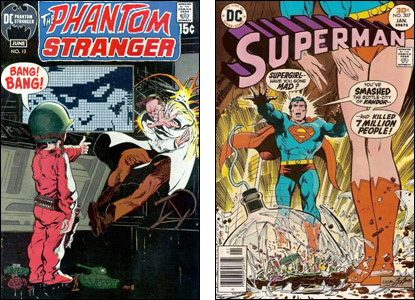Andy Paquette, a friend of mine and a darned good artist, writes to ask…
Another question for your blog: I am wondering whether some comic book covers were "written" and others weren't. I ask because some covers have strong storytelling and others have none or very little. Almost any Curt Swan Superboy, Action Comics, or Superman cover tends to stand on its own as interesting to look at, to read, and to think about. Many DC covers from the same era have the same quality, while later eras do not.
Neal Adams' covers appear to have been done both ways. Sometimes he was given a story and asked to illustrate the story, or he was given a page asking for a specific scene. On other occasions he was told, "just draw Batman in an interesting/dramatic pose." Or so it seems. My favorite Adams cover, or one of them, is from Phantom Stranger. It depicts a boy pretending to shoot a scientist in a lab, who reacts as if actually shot by a real bullet. In another, from Superman, we see a closeup of Supergirl's boots, the bottle city of Kandor smashing to the ground, and Superman yelling, "Supergirl, What have you done?"
I'm curious how many of these were literally written as covers and delivered to artists much like a script page for an interior story. Some have that feel, and some don't, but I have a hard time believing that almost any cover in the last 20 years was done that way.
It seems like a lost art now. It's a shame, because those "story" covers are what often induced me to buy a comic as a kid, and interests me now as a collector.
The answer — and some people who write about comics don't seem to get this — is that there was a lot of variance in how issues of a comic were produced. Julius Schwartz often told of certain issues where they designed and drew a cover and then handed it to a writer and said, "Here — come up with a story that fit this cover." That made a lot of folks assume they did every issue that way and that's not so. Sometimes covers were conceived and/or drawn before and sometimes after.
And at DC during the period you're asking about, Carmine Infantino was in charge of the covers. Sometimes, the basic idea for a cover would start with the writer of a story, sometimes with the book's editor, sometimes with Carmine, sometimes with someone else in the office, sometimes with the artist. I once watched a cover conference where Joe Kubert walked in with three rough sketches based on an idea that Robert Kanigher was then writing. Joe and Carmine discussed the idea, Carmine looked over Joe's sketches, selected one and then marked up the rough to indicate how he wanted a few things changed…and Joe went off and did the finished art.
The whole conference took about six minutes. Later, Schwartz came in with the finished art for an issue of World's Finest Comics. He and Carmine went through it and picked out a scene in the story which might make a good cover, then Carmine did a sketch which was later turned into finished art by Neal Adams.
During this time, Jack Kirby would send in rough sketches for the comics he was writing, drawing and editing for DC and it became obvious to me that he and Carmine had very different ideas about what made a good cover and how to stage a scene. Carmine had the final word there so the covers on Jack's DC books of the time were usually either based on Infantino sketches or Infantino's modifications of Kirby sketches. I personally think that either man was capable of drawing a great cover but when Jack worked over a Carmine layout, the result was inferior to what either would have done on his own.
Neal Adams was in the DC offices a lot. His rough sketches were very impressive and so was he when he "sold" one to Carmine. So he came up with cover ideas around which stories could be written and he also looked at finished stories — or maybe just the scripts — and came up with interesting cover concepts that were kinda/sorta in those stories. It worked many different ways.
So — to finally answer your question — some covers were "written" and some were just someone coming up with an intriguing cover. No hard and fast rule.

